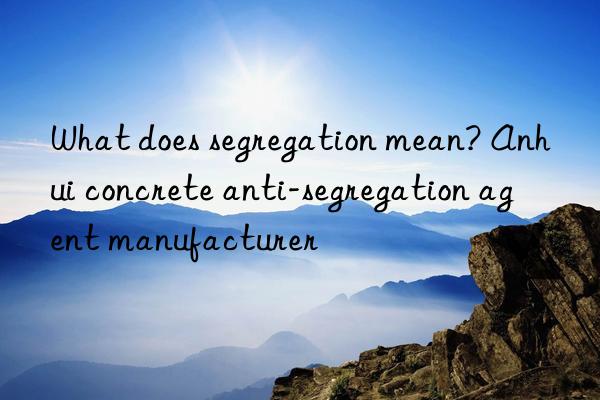
Six major causes of concrete segregation
Concrete segregation refers to the cohesion between the components of the mix. If the strength is insufficient, the components of the mixture will separate from each other, the coarse aggregate will sink, and the mortar will float, resulting in quality defects such as honeycombs, pitted surfaces, and weak interlayers after the concrete hardens.
There are six main reasons for segregation in concrete:
1. Cement:
p>
The stability of cement quality directly affects the stability of concrete quality. Changes in cement quality may cause segregation of concrete.
1. Changes in cement fineness: The higher the cement fineness, the higher its activity, the greater the water demand, and the adsorption of water-reducing agent by cement particles. The stronger the ability, the more water-reducing effect of water-reducing agent can be significantly weakened. Therefore, when the cement fineness suddenly decreases, the water-reducing effect of the admixture will be significantly enhanced. At this time, if the amount of admixture remains unchanged, the water consumption of concrete will be greatly reduced. If not adjusted in time, it is easy to cause excessive dosage of admixtures and segregation.
2. Changes in the alkali content of cement: The alkali content has a great influence on the adaptability of cement and admixtures. The alkali content decreases and the water reducing agent decreases. Water effect enhanced. When the alkali content of cement changes significantly, it may have a greater impact on the viscosity and fluidity of concrete, resulting in segregation.
3. Cement storage and storage time: If cement is not well stored, it is easily affected by moisture, and the water demand will be reduced after getting damp. The longer the cement is stored, the particles will condense into larger particles through adsorption, which reduces the surface energy of the cement particles and weakens the adsorption of the cement particles to the water-reducing agent, which shows that the water-reducing effect of the water-reducing agent is enhanced. If not adjusted in time, it is easy to cause excessive dosage of admixtures and segregation.
2. Admixtures:
If the dosage of concrete water-reducing agent is too large, the If the water rate is too high, the water consumption of a single concrete will be reduced, and the water-reducing agent may not fully play its role in the mixer, but will continue to work during transportation, causing the slump of the concrete to the site to be greater than the slump when leaving the machine. Fall, resulting in segregation.
3. Fly ash:
Fly ash is an important admixture for concrete One, which can greatly improve the workability, compactness and strength properties of concrete. If fly ash quality fluctuates greatly, concrete quality control will become more difficult and segregation will easily occur.
1. When the quality of fly ash suddenly becomes better (such as the fineness changes from 19% to 4%), the water demand of fly ash decreases significantly. Large, it is easy to cause segregation of concrete.
2. When the quality of fly ash suddenly deteriorates (such as the fineness changes from 19% to 38%), due to a large part of the fly ash The function of cementing material has been lost, so the dosage of admixture relative to cementing material has actually increased, and segregation is prone to occur.
4. Aggregate:
Aggregate is the most commonly used material in concrete. Quality directly affects the quality of concrete. Fluctuations in aggregate quality can easily cause segregation of concrete.
1. Increased particle size of coarse aggregate, unreasonable gradation, and single gradation will cause segregation.
2. Excessive flake stone chips in the sand will affect the workability of concrete and cause segregation.
3. The moisture content of the aggregate is too high. When the concrete mixture is mixed in the mixer, the water in the capillary tubes on the surface of the aggregate cannot be released in time, and it is easy to Use too much mixing water. During the transportation process, the water in the capillary tubes is continuously released, causing segregation.
4. Excessive mud content in the aggregate will reduce the bonding force between the cement slurry and the aggregate, and the ability to wrap the aggregate will decrease, leading to the separation of the aggregate. , resulting in segregation.
5. Construction:
After the concrete is delivered to the construction site, workers can freely mix it with the mixture. Adding water will cause the water-cement ratio to increase, the cement mortar to become thinner, the cohesion of the mixture to deteriorate, and segregation to occur.
6. Tank truck:
The concrete tank truck did not drain out the remaining water from the tank washing, resulting in After the concrete is sent to the tanker, the water-cement ratio changes, the mixture becomes thinner, and segregation occurs.



 微信扫一扫打赏
微信扫一扫打赏
